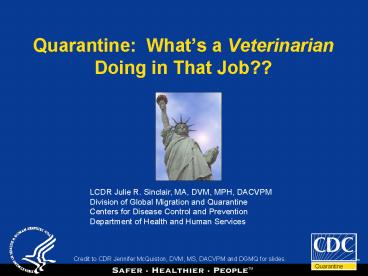Quarantine: Whats a Veterinarian Doing in That Job - PowerPoint PPT Presentation
1 / 17
Title:
Quarantine: Whats a Veterinarian Doing in That Job
Description:
71.56 African rodents. 71.32(b) Persons, carriers, things. 8/12/09. 14 ... Most animals are wild-caught, not captive-raised. No screening prior to shipment ... – PowerPoint PPT presentation
Number of Views:27
Avg rating:3.0/5.0
Title: Quarantine: Whats a Veterinarian Doing in That Job
1
Quarantine Whats a Veterinarian Doing in That
Job??
LCDR Julie R. Sinclair, MA, DVM, MPH,
DACVPM Division of Global Migration and
Quarantine Centers for Disease Control and
Prevention Department of Health and Human Services
Credit to CDR Jennifer McQuiston, DVM, MS, DACVPM
and DGMQ for slides.
2
DISCLAIMER
- "The findings and conclusions in this report are
those of the author(s) and do not necessarily
represent the official position of the Centers
for Disease Control and Prevention."
3
Quarantine and Border Health Services Branch
Mission
To protect the health of the public from
communicable diseases through science,
partnerships, and response at U.S. ports
4
Isolation and Quarantine
- Isolation
- Quarantine
The separation of persons who have a specific
infectious illness from those who are healthy and
the restriction of their movement to stop the
spread of that illness
The separation and restriction of movement of
persons who, while not yet ill, have been exposed
to an infectious agent and therefore may become
infectious
5
History of U.S. Quarantine
- Quarantine laws passed and executed by state or
local authorities - Marine Hospital Service began to administer
quarantine regulations in 1878 - National quarantine system by 1921
- Field office personnel expansion peaks with staff
at every port of entry (1967)
6
History of U.S. Quarantine, cont.
- Pre-1967
- Quarantine Inspectors monitored passengers
disembarking from aircraft, ships, and across
land borders
- Expanded staff enabled direct inspection,
observation, and response
7
History of U.S. Quarantine, cont.
- 1967-2003
- Reorganization of quarantine station system
reduced staff and facilities - Reorientation of quarantine staff roles
- 2003-present
- Newly emerging threats initiated an expansion in
quarantine staff
8
CDC Quarantine Stations 2004 Jurisdictions
AK
ME
Seattle
Chicago
VT
NH
WA
MA
ND
MT
RI
NY
MN
CT
CT
MI
WI
New York
NJ
PA
OR
SD
ID
DE
WY
MD
IA
OH
NE
IN
WV
No.CA
IL
NV
VA
San Francisco
UT
KY
CO
MO
KS
NC
TN
SC
OK
So.CA
AR
Atlanta
NM
AZ
Los Angeles
AL
GA
MS
TX
LA
FL
Miami
Honolulu
PR
HI
GU
CDC Quarantine Station
9
CDC Quarantine Stations 2007 Jurisdictions
AK
ME
Minneapolis
Seattle
Chicago
Anchorage
VT
NH
WA
Boston
MA
ND
MT
Detroit
RI
NY
MN
CT
CT
MI
WI
New York
NJ
PA
OR
SD
ID
Newark
DE
WY
MD
Philadelphia
IA
OH
NE
IN
WV
No.CA
IL
Washington, D.C.
NV
VA
San Francisco
UT
KY
CO
MO
KS
NC
TN
Dallas
SC
OK
So.CA
AR
Atlanta
NM
AZ
Los Angeles
AL
North TX
GA
MS
San Diego
East TX
LA
West TX
El Paso
FL
Houston
Miami
Honolulu
PR
HI
GU
San Juan
CDC Quarantine Station
10
Functions of CDC Quarantine
Stations
- Responding to reports of illnesses on maritime
vessels (cruise, cargo), airplanes, and at land
border crossings - Performing inspections of animals, cargo, and
hand-carried items - Emergency planning, preparedness
11
Functions of CDC Quarantine Stations
- Monitoring health and collecting, distributing,
and managing medical information of immigrants
and refugees - Responding to mass migration emergencies
- Providing travelers with essential health
information
12
HHS/CDC Regulatory Authority
- Secretary of HHS has statutory responsibility for
preventing introduction, transmission, and spread
of communicable diseases in the United States. - At CDC, the Division of Global Migration and
Quarantine administers interstate and foreign
quarantine regulations (42 CFR 71), which govern
the international and interstate movement of
persons, animals, and cargo. - The legal foundation for these activities is
found in Titles 8 and 42 of the US Code and
relevant supporting regulations.
13
CDC Regulatory Authorityfor Importation of
Animals and Animal Products
- 42 CFR 71 (Foreign Quarantine)
- 71.51 Dogs and cats
- 71.52 Turtles, tortoises, and terrapins
- 71.53 Nonhuman Primates
- 71.54 Etiologic agents, hosts, and vectors
- 71.56 African rodents
- 71.32(b) Persons, carriers, things
14
Reasons for Animal Importation
- Incidental / accidental
- Exhibition at zoos
- Education and research
- Scientific conservation programs
- Use as food and products
- Tourism and immigration
- Commercial pet trade
15
Concerns about Wild Animal Importation for
Commerce
- High volume, rapid turn-over
- Most animals are wild-caught, not captive-raised
- No screening prior to shipment
- No holding or testing required on entry
- Opportunity for widespread exposure of public
- High mortality rates (30-50) common
16
Exotic Emerging Zoonoses
- Ebola primates, reservoir unknown
- Nipah bats
- West Nile birds, mosquitoes
- SARS masked palm civets, bats
- Avian Influenza poultry, wild birds
- Monkeypox rodents, primates
EM, Marburg virus, CDC gallery
2001, Pam Brett Whitesell
17
For More Information
www.cdc.gov/ncidod/dq/animal www.cdc.gov/ncidod/
dq/quarantine_stations
DGMQ Zoonoses Team404-639-3441
Nina Marano, DVM, MPH, Dipl ACVPM (Branch
Chief) Gale Galland, DVM Robert Mullan,
MD Sheryl Shapiro, based at JFK Airport































